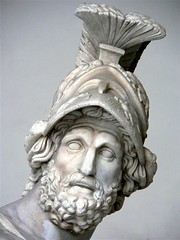Brooks’ Story Structure is, in my opinion, the best prescribed formula for how to place a story together. However, I originally used The Hero’s Journey (hereafter referred to as HJ) to plot out my current WIP. A lot of what is also called “The Mythic Structure”, within the HJ, makes sense as a template as to where to place each item the story needs. One thing I disliked about HJ was the common opinion that you could move items around to your liking, therefore maybe putting certain things in the wrong place.
I have found, however, that HJ is a good characterization tool for creating a proper arc. It can also add understanding to Brooks’ Structure if applied properly. Used together I find that I have a more, well-rounded picture of the story.
 What we recognize as Concept and Theme in Structure, is the Story Question in the HJ. The question I asked is: Can the MC survive being dumped by the man she thought was her life, and move on? A secondary plot question is: Which guy is right for my MC? These questions begin the thought process of how my character is going to grow in this story—the beginning of that character arc.
What we recognize as Concept and Theme in Structure, is the Story Question in the HJ. The question I asked is: Can the MC survive being dumped by the man she thought was her life, and move on? A secondary plot question is: Which guy is right for my MC? These questions begin the thought process of how my character is going to grow in this story—the beginning of that character arc.
The Ordinary World in HJ is the equivalent of Part one: Introduction in Structure. We see the main character, who is at a fancy restaurant, unknowingly waiting for her date to dump her. As character arc, we are finding out what her ordinary world is: what she is thinking, what she is wearing, whether she likes the restaurant and how excited she is about getting married. This is the place for us to start identifying with the MC and establish emotions and rapport with her. Because, when that devastating information comes, we want our reader to be emotionally invested in the MC, enough that they don’t put the book down.
We introduce theme and set things in action by ‘calling the MC to action’, or reaction on her part. The Call to Action in HJ is not plot point #1. Although the event is important, the MC or Heroine, refuses to act. The Call is the boyfriend dumping her in public, which leads us to the Refusal of the Call. My MC goes home and cries, thinking her world is over. She locks herself in her room with a half gallon of ice cream. These actions are giving us more depth into the characters’ personality.
At this point in time we also have what is called Meeting with the Mentor. Sometimes the mentor is the one delivering the call. Sometimes it is the person the MC goes to for advice and help. My MC doesn’t have a “mentor.” She has her friend, who just happens to be a guy, who she goes to for advice and safe friendship after the disastrous date. The relationship between the MC and the mentor is another way that we develop character. How they relate reveals a lot about the MC.
Next, we experience what HJ calls Crossing the First Threshold or plot point #1. The MC is at work, and her friend talks her into going out with his brother. By accepting the date with her friend’s brother, she has accepted that the ex is a jerk and she needs to move on, thus figuratively putting the ice cream securely in the freezer. She moves from what we saw as her ordinary world into the new reality. This area is often a point where our MC struggles to become better and braver, and to take that step into the post-First Threshold world.
Now we enter Part two: reaction, the Tests, Enemies, and Allies stage of the book. This is where the MC adjusts to her new reality—post ex. She begins down a road of new possibilities. Characters, enemies, and trials are introduced during this part. This is where in the “tree” theory after you put your character in the tree, (Crossing the Threshold), you begin to throw small rocks at her. The MC reacts to what her life has dealt her.
As we Approach the Innermost Cave which is Structure’s Mid-point the plot begins to get serious and the “rocks” get a lot bigger. This point is often a place where the writer reveals information to the reader that opens up whole new possibilities. Sometimes the reader knows something that the MC doesn’t even know. My MC finds that she has feelings for both of the brothers. The guy friend finds that he has feelings for the MC too and hates that he has introduced her to his brother. By his “code,” he should back off and let the older brother have his chance with her.
This “reaction” from both the friend and the MC leads us to Part three, proactive stage. This is a time of trials for the MC. She finds out who her real friends are and what she is made of, the previous trials proving her mettle.
As we near The Ordeal, we can have either the “lull moment” where the characters think all is lost and there is no hope, or a “I’ve finally succeeded and this is the end, only to find out it isn’t” moment. My MC has  an all is lost moment, and feels that she will never know who is right for her, and she will be single her whole life. This point in the story is a place where we again feel sympathy for the MC and deepens our concern for what happens to her.
an all is lost moment, and feels that she will never know who is right for her, and she will be single her whole life. This point in the story is a place where we again feel sympathy for the MC and deepens our concern for what happens to her.
The Ordeal or Plot point #2 comes at about [3/4s or] 4/5s way through the book. This is the huge crisis moment, the event that changes everything. After this point in time, no new characters or information may be allowed into the story. The MC is at Thanksgiving with the brother and has had a heated moment with the friend who she thought wasn’t interested. The spark is still there and it has grown stronger. The brother proposes and she has to make a decision—to live a relatively happy life with a good guy, or take a chance with the friend and truly love someone. She says no and runs. The friend follows her at the brother’s request, oblivious to the attraction between them. This is the refining fire for our MC, the culmination of all previous actions. This is where the reader is cheering for the MC to succeed.
Her decision is the Reward. She has proven herself, and has demonstrated to everyone that she has grown and is stronger for it. We are still cheering for her and her success.
What Structure calls Part four, resolution, HJ calls Return With Elixir. The Ordeal brings us massive change in the MC’s life. Now that everything has changed for my MC, she makes decisions that bring about resolution. She confesses her feelings and they finally kiss. They live happily ever after, or at least until the book ends. This is where the MC moves into the new ordinary world and we see not only the comparison to the old world but we see the Story Question answered. We tie up all the loose ends for the reader as well.
What do you think? How would you line up the Hero’s Journey and Story Structure?
About the author
C. Michelle Jefferies practically grew up in a library. When she was ten, she realized she wanted to write stories like the science fiction books she loved to read. A mother of six, she put her writing on the back burner while she focused on raising her young children. When her children were old enough for her to spend a few hours on the computer, without them burning the house down, she returned to writing and hasn’t stopped since. She blogs at My life in a laptop.
Photo credits: path—Kat Gloor; path through structure (bridge)—Jo Ann Deasy

 However, sometimes I’ve been disappointed by the Hero’s Journey as a plotting method—when I expect to look at a list of steps and magically have the list tell me exactly how I should handle each of those scenes. That’s not really what it’s for—we still have to use our imagination.
However, sometimes I’ve been disappointed by the Hero’s Journey as a plotting method—when I expect to look at a list of steps and magically have the list tell me exactly how I should handle each of those scenes. That’s not really what it’s for—we still have to use our imagination. course of the story, and is involved in most of the action. He has a character flaw, of course (if he were
course of the story, and is involved in most of the action. He has a character flaw, of course (if he were  Along the way, the Hero encounters Threshold Guardians who block his path. These obstacles are tests for the Hero—have his skills developed enough? The guardians may be working for the good side or the bad side, or no one at all (but it’s hard to make someone who makes trouble for his own sake believable for very long, you know?)
Along the way, the Hero encounters Threshold Guardians who block his path. These obstacles are tests for the Hero—have his skills developed enough? The guardians may be working for the good side or the bad side, or no one at all (but it’s hard to make someone who makes trouble for his own sake believable for very long, you know?)